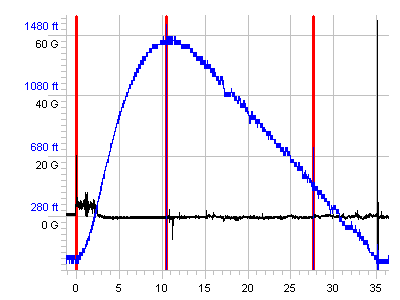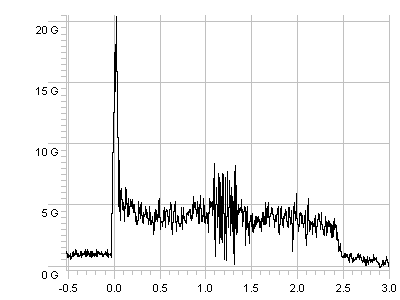R-DAS FLIGHT #11 DETAILS
Flight #: 11
Date: 7th of June, 2002
Venue: UKRA 2002, Pete's Rockets, Heckington, Lincolnshire
R-DAS Type: R-DAS Compact
R-DAS firmware: 3.2
R-DAS Recorded Altitude: 1466 feet (444 metres)
Apogee - Charge Firing Delta-t: 0 seconds
Apogee - Charge Firing Delta-h: 0 feet (0 metres)
Descent Rate at Apogee Deployment: 0 feet per second (0 metres per second)
R-DAS Flight Mode: Apogee & Main Ejection (breakwire launch detection & smart recovery)
Total Time of Flight: 35 seconds
Apogee - Charge Firing h Variance: 0%
Launch Vehicle Diameter: 2.6 inches
Launch Vehicle Length: 6 feet
Launch Vehicle Propulsion: Hypertek I-205 Hybrid
330/54-125-J (0.125 injector orifice)
Fins: 3 clipped swept deltas (Aerofoiled)
Launch System: Rail Launch
Finish: Unfinished
Ejection Method: Electronic Deployment using apogee charge in SafeEject canister, then main charge in SafeEject canister
Ejection Ignition Type: Daveyfire igniters (electric matches)
Launch Vehicle Mass: 2.5 kg (vehicle with hybrid motor but no oxidiser loaded)
Total Propellant Mass: 405 grams
Total Loaded Motor Mass: 1294 grams
Total Impulse: 737 Newton seconds
|
|
 |
| Comments The first flight of the Hephaestus rocket, launched on the Hypertek I-205 hybrid rocket motor (using a 330cc oxidiser tank). The ascent was straight (with the rocket launched from a 6 foot long Black Sky Rail). Two stage recovery was used, with a drogueless first stage deployment at apogee, separating the rocket with 5 metres of 5mm diameter static cord. The PML 44" main chute was set to deploy at 390 feet, but due to a small hole into the payload bay, ejection charge gases leaked into the payload bay, reducing the pressure in the main recovery bay, and causing the chute not to deploy properly. The landing was heavy, although the chute was found deployed. Another 100 feet of deployment altitude, and it would probably have fully inflated. As a consequence, I decided in future, I'd raise the deployment altitude to around 500 feet.
The R-DAS used breakwire launch triggering with smart recovery. This option was again chosen because the oscillation in Hypertek motor combustion has been known to result in irregular launch triggering of the R-DAS. The breakwire and smart recovery option worked perfectly, and both ejection channels fired on cue, however, because of the main recovery system problem, the descent and landing was hard due to the tumbling recovery. A breakwire from Airborne Engineering Limited was fitted, and 2 sounders were also carried on the flight, along with a 433 MHz RF tracking beacon.
| |
 | | Thrust Section of Flight | |
|
 |
|
Tue, Dec 23, 2025, 11:35 GMT
(48)  7:10 7:10  16:21 16:21  10
% 10
% |
|
home - space - research - links - contact me - colophon
Richard Osborne - 1995-2006 |
|